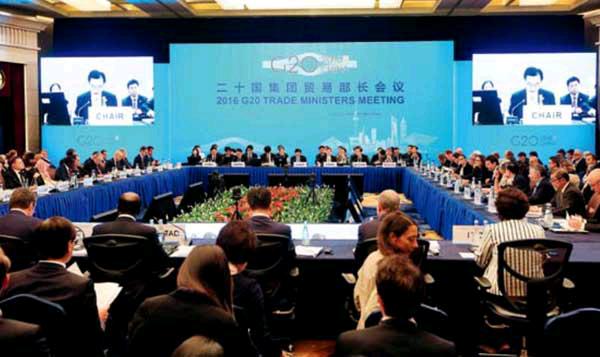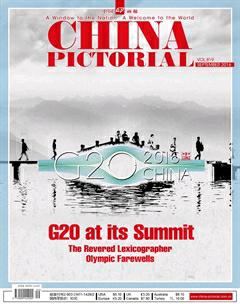G20 to Upgrade Trade
by+Yang+Fanxin+and+Jiang+Ke
Hangzhou in Chinas Zhejiang Province will host the 2016 G20 Summit in September. Since December 1, 2015, when China assumed the rotating presidency of the group, the country has set the agenda to bring the G20 back to economics. In his speech on Chinas hosting of the G20 Leaders Summit, President Xi Jinping listed “invigorating world economy by strengthening international trade and investment” as one of the primary themes of the Summit.
Today, the lingering global financial crisis continues to cause considerable uncertainty. The economic downturn remains, global trade has been stagnant for 18 months, and the trend of trade protectionism is further hampering the global economy.
Member states of the G20 contribute 85 percent of the worlds GDP, 80 percent of trade value, and account for two thirds of the planets population. As both key participants and rule makers of the global economic and financial mechanisms, they shoulder the responsibility of managing mechanism of trade and investment and coordinating macroeconomic policies, particularly in turning trade and investment into driving forces of economic growth by minimizing threats from trade protectionism.
Global consensus remains that trade and investment are an important impetus for economic growth. On July 10, 2016, the G20 Trade Ministers Meeting released G20s first Trade Ministers Statement at its closing ceremony, which revealed a goal of cutting global trade costs by 15 percent.
The G20 Finance Ministers and Central Bank Governors Meeting announced on July 24 that members of the group would work to revitalize global trade and promote investment.
Moreover, on August 10, G20s Business 20 Summit (B20) submitted its Policy Recommendations to the G20 Summit Hangzhou, which suggest measures be taken to “strengthen the multilateral trading system and eliminating new protectionist measures while rolling back existing measures to enable trade growth; ratify the Trade Facilitation Agreement by the end of 2016 and commit to rapid implementation; endorse the concept of the Electronic World Trade Platform (eWTP) to aid e-trade; ease the inclusion of SMEs into global value chains; and enhance the global investment policy environment.” All these show that it has become global consensus that trade and investment should serve as an important impetus for the economic growth.
As chair of the G20 Summit in 2016, China has made great efforts and accomplished remarkable achievements. Thanks to its inspiration and coordination, G20 member states have made breakthroughs in revitalizing trade and investment, devising strategies for global trade growth, and formulating guiding principles to shape policies concerning global investment.
China has been actively participating in global governance and remains committed to promote globalization and global governance through continuously increased trade and investment. The country has accepted the development trend of globalization, respected current global system, and followed the existing global rules on trade and investment. China has taken an open and inclusive stance for the emergence of new systems such as Trans-Pacific Partnership (TPP), with an aim to accelerate the development of globalization and global governance.
Over the past few years, China has provided important public products to optimize trade and investment mechanisms. As the G20s rotating president and the worlds second largest economy, Chinas position and role in the G20 have attracted much attention. Every one of the topics China proposed for discussion met a positive response from attending representatives.
The G20 Trade Ministers Meeting closed on July 10 after making remarkable achievements. Three documents adopted include the G20 Guiding Principles for Global Investment Policymaking, the first of its kind in G20 history, and the G20 Strategy for Global Trade Growth. Two important consensuses were reached on enhancing multilateral trade mechanisms and on taking comprehensive measures to help developing countries and SMEs integrate into global value chains.
The G20 Trade Ministers Meeting realized its institutionalization and issued the first ever G20 Trade Ministers Statement. The achievements also included the World Trade Outlook Indicator, released by the World Trade Organization (WTO) for the first time at the G20 Trade Ministers Meeting, and a strategic paper, reached for the first time, for global trade growth.
Additionally, the G20 Trade Ministers Meeting endorsed the establishment of the G20 Trade and Investment Working Group and approved the Terms of Reference of the working group, suggested and drafted by China, which define the working groups scope of discussions and participants, and requires the group to report its work to the G20 Sherpa Meetings, Trade Ministers Meetings and the G20 Leaders Summits. This will offer a stable institutional guarantee for the G20 to give fuller play to its role in global economic governance and acceleration of global trade and investment growth. All of these provide important public products to improve trade and investment mechanisms.
Statistics released by the WTO and the United Nations Conference on Trade and Development show that in the first quarter of 2016, the global trade volume dropped by 1.1 percent on a quarterly basis and 1 percent year on year. In terms of exports over the same period, North America, Europe, and most Asian countries all suffered a decrease, while Central and South America saw an increase of 3.7 percent, and Africa and the Middle East registered an increase of 4.2 percent. As for imports, Asia and North, Central and South America all witnessed a decline to varying degrees, but Europe had a growth of 0.6 percent thanks to the consumption demands in the Eurozone.
In the first quarter of 2016, Chinas total imports and exports slightly exceeded 5.21 trillion yuan, a year-on-year drop of 5.9 percent. Of these, exports decreased 4.2 percent to stand at 3.01 trillion yuan, while imports, at 2.20 trillion yuan, decreased 8.2 percent, with trade surplus of 8.12 billion yuan registering an increase of 8.5 percent. Despite the fact that it suffered from a hit in the first half of 2016 against the backdrop of sluggish global trade, China performed the best among major economies in the world, contributing a firm support to global trade growth.
China has become a major world power in overseas investment when international capital does not flow smoothly. According to data from American Enterprise Institute-Heritage Foundations China Global Investment Tracker, Chinas overseas direct investment approached US$90 billion in the first half of 2016, surpassing its annual total in the years prior to 2013, with a year-on-year increase of 39 percent. This sharp increase has been mainly contributed by private enterprises. The biggest receiving country of such investment is the United States. In the first six months of 2016, Chinas direct investment in the United States totaled US$35 billion, almost doubling the figure in the same period of last year.
The G20 Summit in Hangzhou will continue to upgrade trade and investment mechanism. China will do everything it can to bring up persisting topics from the Doha Round while working on new topics under the framework of the WTO. The aim is to create a fair, inclusive and sustainable trade and investment environment for the sake of a long-term, stable growth of the global economy.

